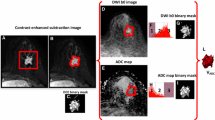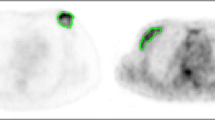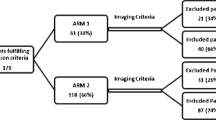Abstract
Purpose
The aim of this study was to evaluate the role of imaging features derived from [18F]FDG-PET/CT to provide in vivo characterization of breast cancer (BC).
Methods
Images from 43 patients with a first diagnosis of BC were reviewed. Images were acquired before any treatment. Histological data were derived from pretreatment biopsy or surgical histological specimen; these included tumor type, grade, ER and PgR receptor status, lymphovascular invasion, Ki67 index, HER2 status, and molecular subtype. Standard parameters (SUVmean, TLG, MTV) and advanced imaging features (histogram-based and shape and size features) were evaluated. Univariate analysis, hierarchical clustering analysis, and exact Fisher’s test were used for statistical analysis of data. Imaging-derived metrics were reduced evaluating the mutual correlation within group of features as well as the mutual correlation between groups of features to form a signature.
Results
A significant correlation was found between some advanced imaging features and the histological type. Different molecular subtypes were characterized by different values of two histogram-based features (median and energy). A significant association was observed between the imaging signature and luminal A and luminal B HER2 negative molecular subtype and also when considering luminal A, luminal B HER2-negative and HER2-positive groups. Similar results were found between the signature and all five molecular subtypes and also when considering the histological types of BC.
Conclusions
Our results suggest a complementary role of standard PET imaging parameters and advanced imaging features for the in vivo biological characterization of BC lesions.




Similar content being viewed by others
References
Breast cancer. In EUCAN facktsheets. International Agency for Research on Cancer. http://eco.iarc.fr/eucan/CancerOne.aspx?Cancer=46&Gender=2. Accessed 15 Jan 2017.
Melchor L, Benítez J. The complex genetic landscape of familial breast cancer. Hum Genet. 2013;132:845–63.
Cybulski C, Wokolorczyk D, Jakubowska A, et al. Risk of breast cancer in women with a CHEK2 mutation with and without a family history of breast cancer. J Clin Oncol. 2011;29:3747–52.
van de Vijver MJ, He YD, van't Veer LJ, et al. A gene-expression signature as a predictor of survival in breast cancer. N Engl J Med. 2002;347:1999–2009.
Cheang MC, Chia SK, Voduc D, et al. Ki67 index, HER2 status, and prognosis of patients with luminal B breast cancer. J Natl Cancer Inst. 2009;101:736–50.
Esposito A, Criscitiello C, Curigliano G. Highlights from the 14(th) St Gallen international breast cancer conference 2015 in Vienna: dealing with classification, prognostication, and prediction refinement to personalize the treatment of patients with early breast cancer. Ecancermedicalscience. 2015;9:518.
Kennecke H, Yerushalmi R, Woods R, et al. Metastatic behavior of breast cancer subtypes. J Clin Oncol. 2010;28:3271–7.
Gallivanone F, Canevari C, Sassi I, et al. Partial volume corrected 18F-FDG PET mean standardized uptake value correlates with prognostic factors in breast cancer. Q J Nucl Med Mol Imaging. 2014;58:424–39.
Kaida H, Toh U, Hayakawa M, et al. The relationship between 18F-FDG metabolic volumetric parameters and clinicopathological factors of breast cancer. Nucl Med Commun. 2013;34:562–70.
García Vicente AM, Soriano Castrejón Á, León Martín A, et al. Molecular subtypes of breast cancer: metabolic correlation with 18F-FDG PET/CT. Eur J Nucl Med Mol Imaging. 2013;40:1304–11.
Koo HR, Park JS, Kang KW, et al. 18F-FDG uptake in breast cancer correlates with immunohistochemically defined subtypes. Eur Radiol. 2014;24:610–8.
Kajáry K, Tőkés T, Dank M, et al. Correlation of the value of 118F-FDG uptake, described by SUVmax, SUVavg, metabolic tumour volume and total lesion glycolysis, to clinicopathological prognostic factors and biological subtypes in breast cancer. Nucl Med Commun. 2015;36:28–37.
Kitajima K, Fukushima K, Miyoshi Y, et al. Association between 18F-FDG uptake and molecular subtype of breast cancer. Eur J Nucl Med Mol Imaging. 2015;42:1371–7.
Lee SS, Bae SK, Park YS, et al. Correlation of molecular subtypes of invasive ductal carcinoma of breast with glucose metabolism in FDG PET/CT: based on the recommendations of the St. Gallen consensus meeting 2013. Nucl Med Mol Imaging. 2017;51:79–85.
Leijenaar RT, Carvalho S, Hoebers FJ, et al. External validation of a prognostic CT-based radiomic signature in oropharyngeal squamous cell carcinoma. Acta Oncol. 2015;54:1423–9.
Carvalho S, Leijenaar RT, Velazquez ER, et al. Prognostic value of metabolic metrics extracted from baseline PET images in NSCLC in non small cell lung cancer. Acta Oncol. 2015;52:1398–404.
Vallières M, Freeman CR, Skamene SR, El Naqa I. A radiomics model from joint FDG-PET and MRI texture features for the prediction of lung metastases in soft-tissue sarcomas of the extremities. Phys Med Biol. 2015;60:5471–96.
Son SH, Kim DH, Hong CM, et al. Prognostic implication of intratumoral metabolic heterogeneity in invasive ductal carcinoma of the breast. BMC Cancer. 2014;14:585.
Shin S, Pak K, Park DY, Kim SJ. Tumor heterogeneity assessed by 18F-FDG PET/CT is not significantly associated with nodal metastasis in breast cancer patients. Oncol Res Treat. 2015;39:61–6.
Soussan M, Orlhac F, Boubaya M, et al. Relationship between tumor heterogeneity measured on FDG-PET/CT and pathological prognostic factors in invasive breast cancer. PLoS One. 2014;9(4):e94017.
Yoon HJ, Kim Y, Kim BS. Intratumoral metabolic heterogeneity predicts invasive components in breast ductal carcinoma in situ. Eur Radiol. 2015;25:3648–58.
Agner SC, Rosen MA, Englander S, et al. Computerized image analysis for identifying triple-negative breast cancers and differentiating them from other molecular subtypes of breast cancer on dynamic contrast-enhanced MR images: a feasibility study. Radiology. 2014;272:91–9.
Grimm LJ, Zhang J, Mazurowski MA. Computational approach to radiogenomics of breast cancer: luminal a and luminal B molecular subtypes are associated with imaging features on routine breast MRI extracted using computer vision algorithms. J Magn Reson Imaging. 2015;42:902–7.
Yamaguchi K, Abe H, Newstead GM, et al. Intratumoral heterogeneity of the distribution of kinetic parameters in breast cancer: comparison based on the molecular subtypes of invasive breast cancer. Breast Cancer. 2015;22:496–502.
Li H, Zhu Y, Burnside ES, et al. Quantitative MRI radiomics in the prediction of molecular classifications of breast cancer subtypes in the TCGA/TCIA data set. NPJ Breast Cancer. 2016;2:16012.
Groheux D, Majdoub M, Tixier F, et al. Do clinical, histological or immunohistochemical primary tumour characteristics translate into different 18F-FDG PET/CT volumetric and heterogeneity features in stage II/III breast cancer? Eur J Nucl Med Mol Imaging. 2015;42:1682–91.
Koo HR, Park JS, Kang KW, et al. Correlation between 18F-FDG uptake on PET/CT and prognostic factors in triple-negative breast cancer. Eur Radiol. 2015;25:3314–21.
Ha S, Park S, Bang J-I, et al. Metabolic radiomics for pretreatment (18)F-FDG PET/CT to characterize locally advanced breast cancer: histopathologic characteristics, response to neoadjuvant chemotherapy, and prognosis. Sci Rep. 2017;7:1556.
Pinder SE, Provenzano E, Earl H, Ellis IO. Laboratory handling and histology reporting of breast specimens from patients who have received neoadjuvant chemotherapy. Histopathology. 2007;50:409–17.
Boellaard R, Delgado-Bolton R, Oyen WJG, et al. FDG PET/CT: EANM procedure guidelines for tumour imaging: version 2.0. Eur J Nucl Med Mol Imaging. 2015;42:328–54.
Gallivanone F, Interlenghi M, Canervari C, Castiglioni I. A fully automatic, threshold-based segmentation method for the estimation of the metabolic tumor volume from PET images: validation on 3D printed anthropomorphic oncological lesions. J Instrum. 2016;11:C01022.
Gallivanone F, Stefano A, Grosso E, et al. PVE correction in PET-CT whole-body oncological studies from PVE-affected images. IEEE Trans Nucl Sci. 2011;58:736–47.
Gallivanone F, Canevari C, Gianolli L, et al. A partial volume effect correction tailored for 18 F-FDG-PET oncological studies. Biomed Res Int. 2013;2013:1–12.
Gallivanone F, Interlenghi M, D’Ambrosio D, et al. An anthropomorphic phantom for advanced image processing of realistic 18F–FDG PET-CT oncological studies. IEEE Nuclear Science Symposium and Medical Imaging Conference Record (NSS/MIC) M04D-20. 2016.
Aerts HJ, Velazquez ER, Leijenaar RT, et al. Decoding tumour phenotype by noninvasive imaging using a quantitative radiomics approach. Nat Commun. 2014;5:4006.
Chen X, Ma C, Wu J, et al. Molecular subtype approximated by quantitative estrogen receptor, progesterone receptor and Her2 can predict the prognosis of breast cancer. Tumori. 2010;96:103–10.
Groheux D, Giacchetti S, Moretti JL, et al. Correlation of high 18F-FDG uptake to clinical, pathological and biological prognostic factors in breast cancer. Eur J Nucl Med Mol Imaging. 2011;38:426–35.
Zhao YH, Zhou M, Liu H, et al. Upregulation of lactate dehydrogenase a by ErbB2 through heat shock factor 1 promotes breast cancer cell glycolysis and growth. Oncogene. 2009;28:3689–701.
Senkus E, Kyriakides S, Ohno S, et al. Primary breast cancer: ESMO clinical practice guidelines for diagnosis, treatment and follow-up. Ann Oncol. 2015;26:v8–30.
Tixier F, Le Rest CC, Hatt M, et al. Intratumor heterogeneity characterized by textural features on baseline 18F-FDG PET images predicts response to concomitant radiochemotherapy in esophageal cancer. J Nucl Med. 2011;52:369–78.
Van Velden FHP, Cheebsumon P, Yaqub M, et al. Evaluation of a cumulative SUV-volume histogram method for parameterizing heterogeneous intratumoural FDG uptake in non-small cell lung cancer PET studies. Eur J Nucl Med Mol Imaging. 2011;38:1636–47.
Hatt M, Tixier F, Cheze Le Rest C, et al. Robustness of intratumour 18F-FDG PET uptake heterogeneity quantification for therapy response prediction in oesophageal carcinoma. Eur J Nucl Med Mol Imaging. 2013;40:1662–71.
Sollini M, Cozzi L, Antunovic L, et al. PET Radiomics in NSCLC: state of the art and a proposal for harmonization of methodology. Sci Rep. 2017;7:358.
Author information
Authors and Affiliations
Corresponding author
Ethics declarations
Funding
This study was not funded.
Conflict of interest
All authors declare that they have no conflicts of interest.
Ethical approval
This retrospective study was approved by the local Ethics Committee.
Informed consent
Informed consent for this retrospective study was obtained from all individual participants included in the study, as part of the consent signed when admitted in the hospital or when submitted to diagnostic procedures.
Rights and permissions
About this article
Cite this article
Antunovic, L., Gallivanone, F., Sollini, M. et al. [18F]FDG PET/CT features for the molecular characterization of primary breast tumors. Eur J Nucl Med Mol Imaging 44, 1945–1954 (2017). https://doi.org/10.1007/s00259-017-3770-9
Received:
Accepted:
Published:
Issue Date:
DOI: https://doi.org/10.1007/s00259-017-3770-9




